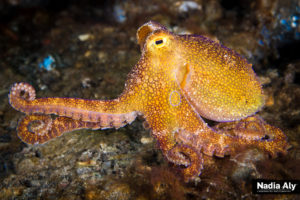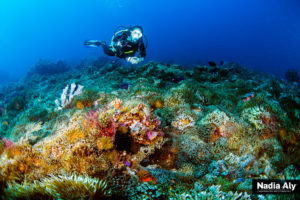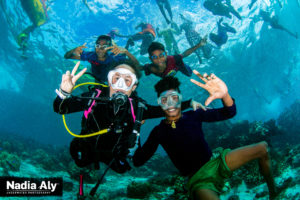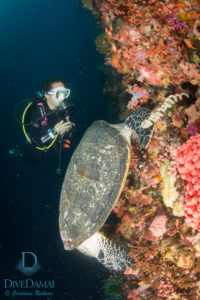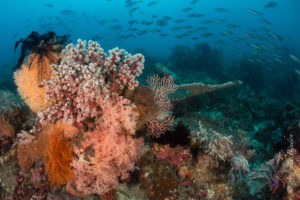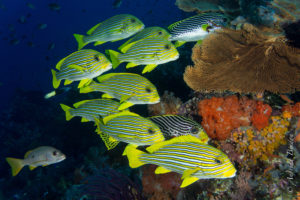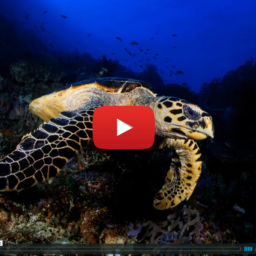Twelve days on the Damai Dua (Damai II) liveaboard offered an embarrassment of riches when it comes to dive sites. Those onboard will sample everything from muck, to walls, to manta dives. Here are our picks for the top seven dive sites in Komodo and Alor from our cruise onboard Damai Dua.
 Baeangabang
Baeangabang
This melodiously named site, pronounced Bay-ONG-a-bong, is in Baeang Bay in south Pantar, the second-largest island in the Alor archipelago. Famed for cephalopod sightings, the bay fronts a little black-sand beach and is an absolute must for muck-lovers. We began on a sandy slope, covered with sea pens in both pinks and purples. In about 30 feet (10 m) of water, we spotted an oscillated octopus immediately. Urged on by a gentle current, we rolled slowly over the slope, finding two more octopus, tons of juvenile scorpionfish, a black-finned snake eel, lionfish and cuttlefish. The dive ended in a lovely, waving soft-coral garden with trees of purple, pink and orange.
 Valley of the Clowns
Valley of the Clowns
Another Alor must, the Valley of the Clowns (also called Clown Valley or Anemone City) sits offshore of small Pura Island. The site consists almost entirely of an endless, waving carpet of anemones of every shape and size, as far as the eye can see. You’ll drop in over the field and, if you’re anything like me, become instantly mesmerized, watching the anemones sway hypnotically in the surge, back and forth. About half the anemones are occupied by grouchy clownfish, from whom the site gets its name. Get too close and these territorial pipsqueaks will give you what for. Get as low as you can and just peer over the endless landscape; you won’t need to get much deeper than 40 feet (12 m).
 Anak Anak Alor
Anak Anak Alor
Also off Pura, this dive is unique not for the marine life you’ll encounter, but for the abundant juvenile humans on the site. A few years ago, as the story goes, a boy was spearfishing with his grandpa and spotted a liveaboard. Soon thereafter, he and his friends paddled out and jumped in the water to say hello. Now, each time a dive boat appears, dozens of kids from the local village of Tola Bali swim offshore into about 15 feet (4.5 m) of water and dive down, mugging for divers’ cameras in their home-made swim goggles (if any), made from the bottom of soda bottles.
 Batu Bolong
Batu Bolong
The first of our dive sites in Komodo, Batu Bolong is another can’t-miss site. The dive briefing will be necessarily serious — there are downcurrents here, and divers have been swept away. But if you follow briefing instructions and your guide, you’re in for a treat on this small, rocky pinnacle in a main channel. The top of the rock peeks out from the waves, and you’ll spiral down to around 100 feet (30 m) and back up again, around a substrate covered in hard and soft coral just bursting with color. The currents draw all manner of marine life, from small fish to passing rays and sharks. I saw the largest hawksbill turtle of my life, happily munching on coral as we came near, utterly nonplussed by our presence.
 Castle Rock
Castle Rock
Castle and Crystal Rocks are equally famous among dive sites in Komodo, the former known colloquially among liveaboard dive guides as “hard to find,” and the latter known as “easy to find.” Our first dive was at Castle Rock, hard to find because the underwater pinnacle starts about 50 feet (15 m) below the surface. Although we had to swim against an insistent current to reach the edge of the pinnacle, the effort was worth it, checking out schooling jacks, giant triggerfish, pinnate spadefish and schooling Moorish idols along the way. The view of three big whitetip sharks, just over the edge of the rock, made the journey worthwhile.
Crystal Rock
Next up was Crystal Rock, which is easy to find because the top of the pinnacle starts just below the water’s surface. Dive guides can easily spot its peak during low tide. Although current forced us to the lee side of this pinnacle as well, once we got into the protected area, the site itself was lovely, with the crystal-clear water its name promised. The pinnacle is covered in vibrant soft coral and lots of fish – harlequin sweetlips, oriental sweetlips, anthias, surgeonfish and more — swirled about.
Takat Makassar
This long, unremarkable channel holds treasure: small coral bommies along its width feature multiple manta cleaning stations. On this drift dive, you’ll drop in at one end and let the current carry you through the channel. Our dive was like a movie reel where the mantas just kept coming and coming. We’d stop at one bommie and they’d circle overhead. We’d look to the right, see more up ahead, and just drift from one bommie to the next. We saw a manta train of seven at once, all within touching distance (which of course we didn’t do). With a maximum depth of 50 feet (15 m), there’s time to savor the experience.


